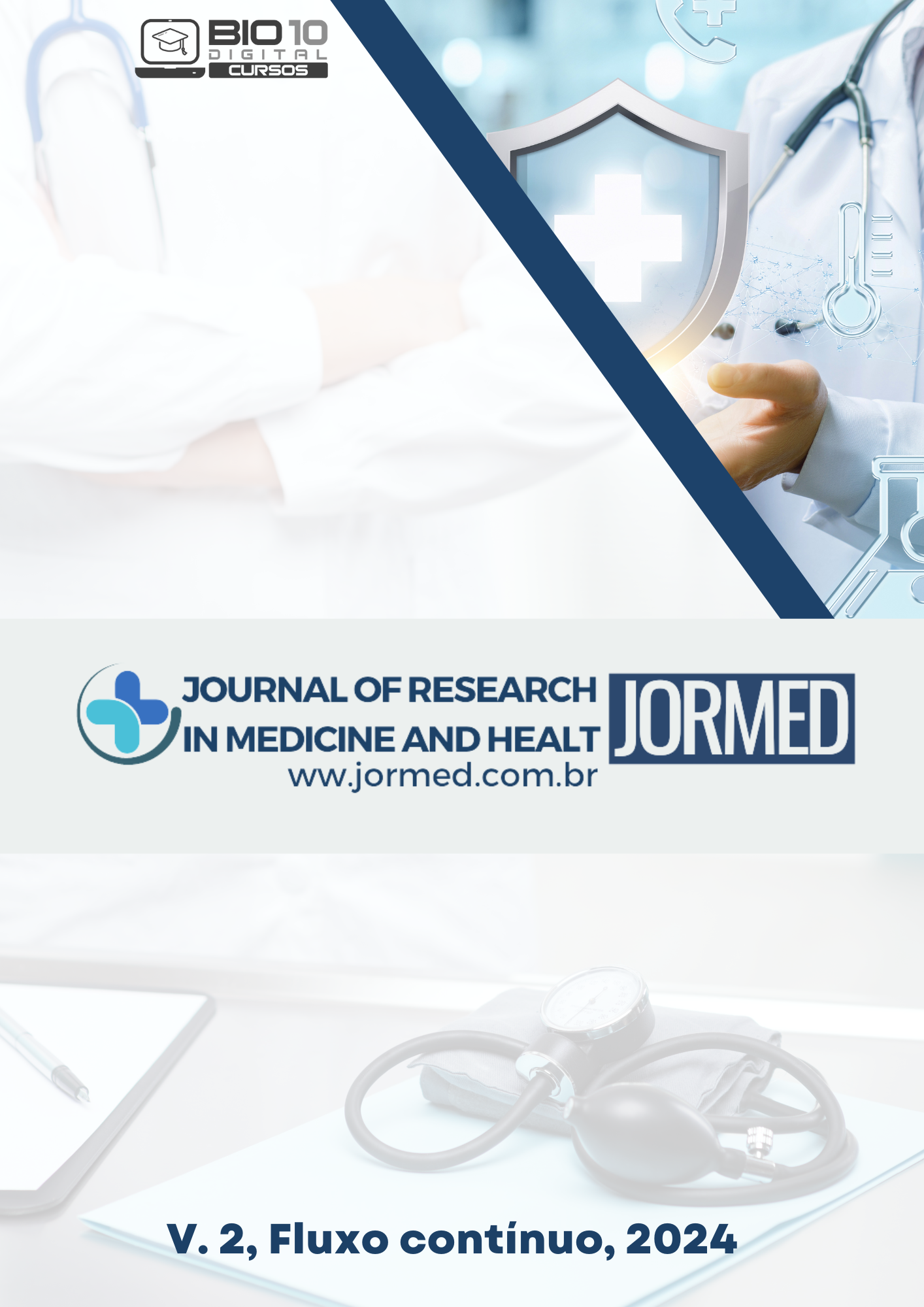Immunohistochemistry in Breast Cancer Diagnosis: Main Protein Markers
DOI:
10.52832/jormed.v2.433Keywords:
Breast cancer, Immunohistochemistry, HER2 protein.Abstract
Introduction: Breast cancer (BC) is a malignant neoplasm that has a considerable impact on women's lives and is one of the main causes of mortality among women. Its prevalence and severity highlight the importance of ongoing research to deepen our understanding of this disease. Objective: To explore the role of immunohistochemistry as an essential tool in the diagnosis and prognostic evaluation of CM. Methods: This is a literature review using scientific articles from the US National Library of Medicine (PubMed) and Scientific Electronic Library Online (SciELO) databases. To identify the relevant studies, descriptors from DeCS (Health Sciences Descriptors) were used with the Boolean operator “AND”, including the terms “Breast cancer”, “Immunohistochemistry” and “HER2+ protein”. Free full texts, published in peer-reviewed journals, available in English and Portuguese, and studies published between 2019 and 2023. Studies that were not directly related to the proposed topic were excluded from the analysis. Results: Immunohistochemistry demonstrates efficacy in accurately detecting the HER2+ protein in breast cancer, and is essential for assessing prognostic factors and differentiating lesions in breast tissue. Its ability to reliably identify the protein and discriminate between different types of BC contributes to a more precise and personalized therapeutic approach, improving patients' clinical outcomes. Conclusion: Immunohistochemistry is crucial in the diagnosis and understanding of breast cancer. In addition to confirming the diagnosis, it identifies the presence of HER2+ and other markers, influencing therapeutic and prognostic decisions. This personalized approach promotes more effective treatment, highlighting the importance of immunohistochemistry in the management of BC.
References
Bonacho, T., Rodrigues, F., & Liberal, J. (2020). Immunohistochemistry for diagnosis and prognosis of breast cancer: a review. Biotechnic & histochemistry : official publication of the Biological Stain Commission, 95(2), 71–91. https://doi.org/10.1080/10520295.2019.1651901
Cambruzzi E, Pêgas Kl, Ferrari MB. Avaliação imuno-histoquímica de 100 casos de metástases encefálicas e correlação com o sítio primário do tumor. J Bras Patol Med Lab [Internet]. 2011Feb;47(1):57–64. Available from: https://doi.org/10.1590/S1676-24442011000100008
Cimino-Mathews A. (2021). Novel uses of immunohistochemistry in breast pathology: interpretation and pitfalls. Modern pathology : an official journal of the United States and Canadian Academy of Pathology, Inc, 34(Suppl 1), 62–77. https://doi.org/10.1038/s41379-020-00697-3
Dass, S. A., Tan, K. L., Selva Rajan, R., Mokhtar, N. F., Mohd Adzmi, E. R., Wan Abdul Rahman, W. F., Tengku Din, T. A. D. A., & Balakrishnan, V. (2021). Triple Negative Breast Cancer: A Review of Present and Future Diagnostic Modalities. Medicina (Kaunas, Lithuania), 57(1), 62. https://doi.org/10.3390/medicina57010062
Direito I. et al. The Clinicopathological Significance of BiP/GRP-78 in Breast Cancer: A Meta-Analysis of Public Datasets and Immunohistochemical Detection. Current oncology, v. 29, n. 12, p. 9066–9087, 23 nov. 2022.
Fujiyama, S., Nakahashi-Oda, C., Abe, F., Wang, Y., Sato, K., & Shibuya, A. (2019). Identification and isolation of splenic tissue-resident macrophage sub-populations by flow cytometry. International immunology, 31(1), 51–56. https://doi.org/10.1093/intimm/dxy064
Holm, J. et al. Concordance of Immunohistochemistry-Based and Gene Expression-Based Subtyping in Breast Cancer. JNCI cancer spectrum, v. 5, n. 1, 7 out. 2020.
Leeha, M., Kanokwiroon, K., Laohawiriyakamol, S., & Thongsuksai, P. (2023). Immunohistochemistry-based molecular subtyping of triple-negative breast cancer and its prognostic significance. Pathology oncology research : POR, 29, 1611162. https://doi.org/10.3389/pore.2023.1611162
Loibl, S., Poortmans, P., Morrow, M., Denkert, C., & Curigliano, G. (2021). Breast cancer. Lancet (London, England), 397(10286), 1750–1769. https://doi.org/10.1016/S0140-6736(20)32381-3
Magaki, S., Hojat, S. A., Wei, B., So, A., & Yong, W. H. (2019). An Introduction to the Performance of Immunohistochemistry. Methods in molecular biology (Clifton, N.J.), 1897, 289–298. https://doi.org/10.1007/978-1-4939-8935-5_25
Magnoni, F., Galimberti, V., Corso, G., Intra, M., Sacchini, V., & Veronesi, P. (2020). Axillary surgery in breast cancer: An updated historical perspective. Seminars in oncology, 47(6), 341–352. https://doi.org/10.1053/j.seminoncol.2020.09.001
Moreno, V., Smith, E. A., & Piña-Oviedo, S. (2022). Fluorescent Immunohistochemistry. Methods in molecular biology (Clifton, N.J.), 2422, 131–146. https://doi.org/10.1007/978-1-0716-1948-3_9
Tarantino, P., Gandini, S., Nicolò, E., Trillo, P., Giugliano, F., Zagami, P., Vivanet, G., Bellerba, F., Trapani, D., Marra, A., Esposito, A., Criscitiello, C., Viale, G., & Curigliano, G. (2022). Evolution of low HER2 expression between early and advanced-stage breast cancer. European journal of cancer (Oxford, England : 1990), 163, 35–43. https://doi.org/10.1016/j.ejca.2021.12.022
Wolff, A. C. et al. Human Epidermal Growth Factor Receptor 2 Testing in Breast Cancer. Archives of pathology & laboratory medicine, v. 147, n. 9, p. 993–1000, 7 jun. 2023.
Yin, L., Duan, J. J., Bian, X. W., & Yu, S. C. (2020). Triple-negative breast cancer molecular subtyping and treatment progress. Breast cancer research : BCR, 22(1), 61. https://doi.org/10.1186/s13058-020-01296-5
Zhang, Y. N., Xia, K. R., Li, C. Y., Wei, B. L., & Zhang, B. (2021). Review of Breast Cancer Pathologigcal Image Processing. BioMed research international, 2021, 1994764. https://doi.org/10.1155/2021/1994764
Downloads
Published
How to Cite
Issue
Section
License
Copyright (c) 2024 Journal of Research in Medicine and Health

This work is licensed under a Creative Commons Attribution-NonCommercial 4.0 International License.



